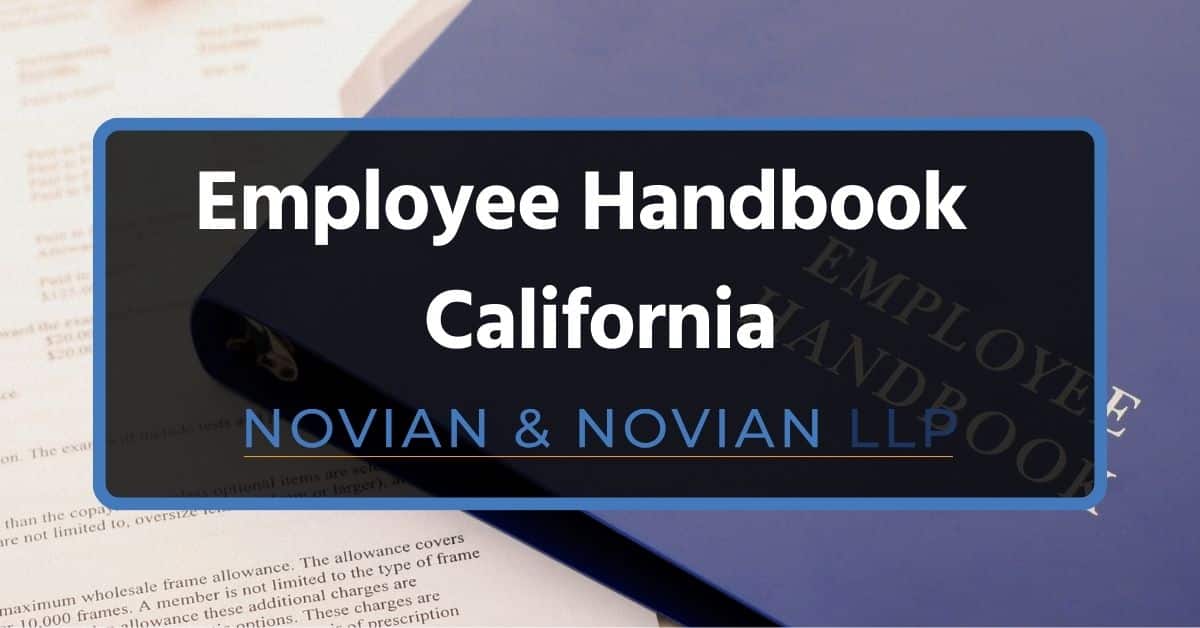
by | Nov 24, 2023 | Employee Issues
An employee handbook is an important document that explicitly lays out a workplace’s policies and procedures, while establishing a clear and concise record of the information.
A great employee handbook serves as a comprehensive guide for employees and helps protect the employer by clearly outlining policies and expectations.
At Novian & Novian, we give insightful counsel to employers on how best to avoid litigation. But in cases where it is inevitable, we have skilled lawyers and professionals that will defend your best interests in court.
For this blog post, we’ll explore key components necessary for an employee handbook in California. It would also guide California employers in creating a comprehensive and compliant employee handbook.
The Basics of Understanding California Employment Law
California employment laws have a reputation for being one of the most comprehensive and employee-friendly in the United States. The aim of these laws is to protect work and ensure fairness in the workplace.
While building up an employee handbook, employers must make sure that it complies with California employment laws. It is always necessary to work with an employment lawyer during the drafting process.
Sexual harassment policies, health and safety, and leaves of absence are some important policies that should be mentioned when drafting a California employee handbook.
As an employer, having a comprehensive and compliant handbook shows your commitment to comply with employment laws. It also educates your employees on California-specific laws and employer’s policies.
Key Components of an Employee Handbook
In tailoring your employee handbook to comply with California’s employment laws, there are key components to consider. Below are essential employee handbook requirements.
1. Anti-Discrimination Policies
These policies are mainly governed by the Fair Employment and Housing Act (FEHA). They aim to promote a fair, equal, and diverse workplace.
Key points under this policy include:
Protected Categories: Employers are prohibited from discriminating against employees based on color, gender, sex, race, national origin, disability, age, sexual orientation, religion, etc.
Harassment and Retaliation: Harassment goes beyond sexual harassment. It could be visual, verbal, or even physical. FEHA frowns against all forms of harassment against individuals who assert their rights under the law.
Reasonable Accommodation: Employers are required to provide reasonable accommodations for employees with disabilities. While this is a requirement under the law, employers are not obligated to do so if it would cause undue hardship to the business.
In your best interest as an employer, your written policies should be non-discriminatory. Your handbook should have a clear outline for addressing employee complaints. It should clearly outline procedures for investigating complaints and specify the consequences for violating anti-discrimination policies.
2. Wage and Hour Laws
Employers need to understand these laws to maintain compliance and fair working conditions. The laws under this category are:
Minimum Wage: California set its own minimum wage aside from what’s under the federal law. California’s minimum wage is higher and it require employers to comply with the state’s minimum wage.
Overtime Pay: The regular working schedule in California is 8 hours per work day or 40 hours in a week. Anything that goes beyond this schedule requires an extra payment. Double-time pay is compulsory for hours worked beyond 12 in a day.
Meal and Rest: For breaks, employees are entitled to a 30-minute meal break after five hours of work a 10-minute rest break for every four hours worked for meals, and a 10-minute rest break for every four hours worked for rest.
These laws are in place for fair compensation and to ensure employees get adequate breaks. As an employer, complying with them shows you are running an equitable workplace.
3. Leave Policies and Procedures
Taking time off must also be covered under California employee handbooks. Employers must be well-versed in these laws to ensure compliance and fairness.
Some types of leaves mandated by the state and federal law are:
Sick Leave: California requires employers to provide paid sick leave to employees. However, employers may create company policies to cap it. The paid time off for sick leave may be limited to 24 hours or three days in each employment year.
Family Leave: According to the California Family Rights Act (CFRA), employees may take up to 12 weeks of unpaid leave in a year. It could be for child birth or adoptions, health issues of the employee or family member, etc.
Maternity Leave: If you’re an employer with more than 5 employees, you’re mandated under the state and federal law to provide Pregnancy Disability Leave (PDL). It provides up to 4 months of leave for pregnancy, childbirth, or related medical issues.
4. Health and Safety Regulations
Employers must comply with Cal/OSHA standards to create a safe workplace. You would do this by ensuring that your employee handbook covers issues such as hazard communication, injury and illness prevention, and record keeping.
In order to incorporate health and safety policies in the employee handbook, California employers can discuss safety responsibilities, emergency procedures, training requirements, and compliance information. This lets you show how the company aids compliance with Cal/OSHA standards.
Sections That Must Be in Your Employee Handbook
Below are necessary sections for your employee handbook
Mission and Values
Asides from stating your company’s mission statement in the employment contract, it should also be in the handbook. It emphasizes the importance of these princes in daily operations.
Job Roles and Responsibilities
Clearly outline expectations for different roles within your organization. According to employment laws, it is what you would use to track employee performance.
Industry-Specific Regulations
It is important for employees to have a reference on what goes on within the industry the company is operating. This section lets you address industry-specific laws and regulations.
Company Size
California policies vary, depending on company size. Smaller businesses may have different needs and resources compared to larger organizations. Clearly state what applies to your organization in this section.
Flexibility
Most employers let new employees know the current policies in this category. For example, it can state if the company embraces remote work.
Performance Expectations
Here, you can clearly define performance expectations relevant to your business objectives. It lets employees understand the employment policy and how you set expectations.
Communication Style
Employees get to know about the company culture in this section. It conveys the tone and language of the organization.
Inclusivity
Use this section of your California employee handbook to highlight your commitment to diversity and equal employment. Let it also highlight the value your company upholds in terms of inclusion.
Employee Testimonials
Employee handbooks should contain this section where past employees share their working experience. Through this, new employees will understand the intended working relationship.
Recognition and Rewards
Use this section of the employee handbook to talk about recognition and rewards programs. It showcases your company as one with initiatives to foster a positive and rewarding work environment.
Legal Considerations and Compliance
You can conduct a legal review of your employee handbook and seek legal advice from legal professionals who are experts in employment law.
The employee handbooks should reflect compliance with any local ordinances and federal laws that apply to your business. Importantly, you must make sure that your handbook is available in languages spoken by a significant percentage of your workforce to comply with California’s language translation requirements.
Employee handbooks must also be accessible to employees with disabilities. This is in compliance with the Americans with Disabilities Act (ADA) and state accessibility standards.
By prioritizing legal compliance, your employee handbooks can serve as a valuable tool for minimizing legal risks. Regular legal reviews and updates are essential to maintaining a legally sound and effective handbook.
The Role of a Handbook in Resolving Employee Disputes
When hiring employees, you should keep in mind that disputes are bound to happen. Employee handbook requirements entail enlisting how to document employee issues.
While the employee handbook covers company policies, it also plays roles in resolving employee disputes by:
Serving as Reference
The handbook serves as a reference guide for employees. It provides information on employment policy and expectations. It also encourages employees to consult the handbook before raising concerns.
Offering Consistency in Enforcement
When disputes arise, the handbook helps ensure consistent enforcement of required policies. Refer to specific sections of the handbook that address the relevant issues.
Disputing Resolution Procedures
Clearly outline dispute resolution procedures in the handbook. This may include steps such as informal discussions, mediation, or formal grievance procedures.
Documenting Policies
The handbook’s documentation of required policies and procedures serves as a foundation for resolving disputes. Make sure that policies are clear, fair, and legally sound to minimize potential conflicts.
Mediating Arbitration Clauses
If applicable and legally permissible, include clauses in the handbook that outline procedures for mediation or arbitration to resolve disputes efficiently and cost-effectively.
Conclusion
In the California workplace, a well crafted employee handbook is necessary as it serves as a set of rules that guides employees. However, it is also one of the legal requirements for employers if any issue arises.
You do not have to go through legal procedures alone.
Contact us now for legal advice on employment laws.
Contact Us
Have questions about this post? Novian & Novian is a full service law firm in Los Angeles with clients that span the country. Contact us today for a free consultation.
Contact Us
Have questions about this post? Novian & Novian is a full service law firm in Los Angeles with clients that span the country. Contact us today for a free consultation.




